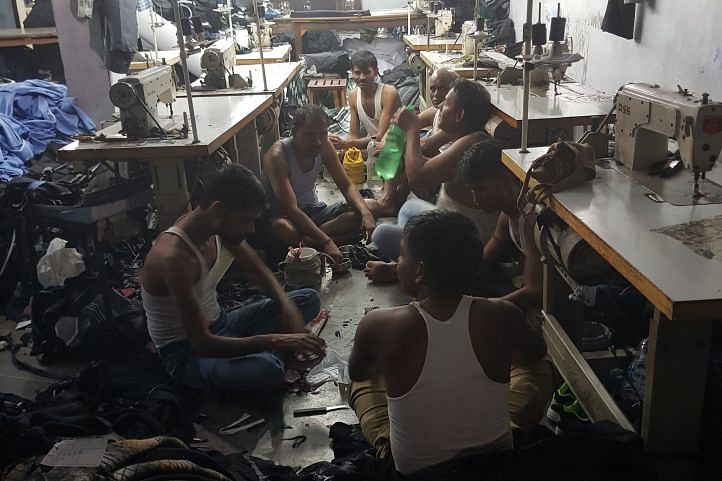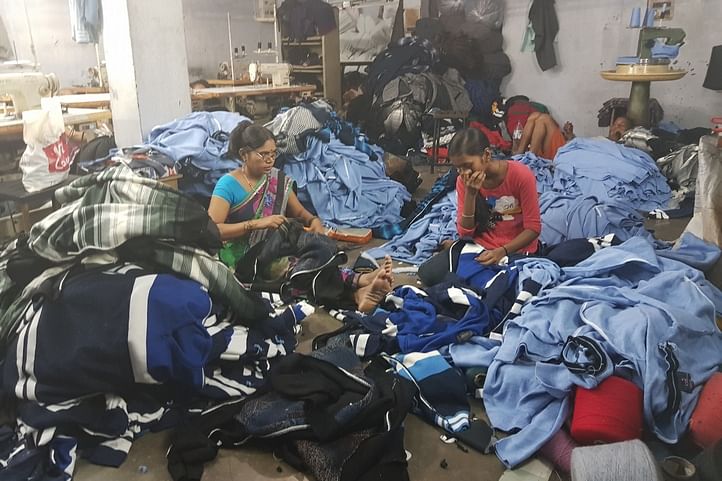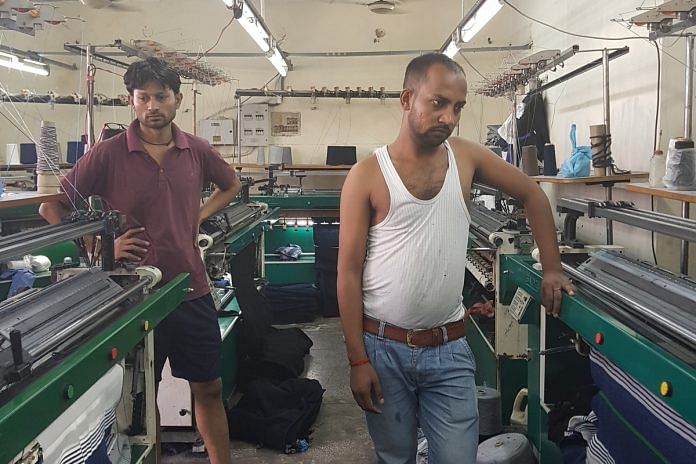Daily labourers are worst affected, but permanent employees could also lose jobs as GST hits 12,000 hosiery units in the Ludhiana area.
Ludhiana: Manga Ram is proud that he works each day of each month. Despite his young age of 26, he’s an old hand in a hosiery factory in Ludhiana. But something around him has changed.
“There were 80-90 men working with me in this factory. Now there are only 50,” Manga Ram says.
First came demonetisation, then the Goods and Services Tax (GST). Now, the hosiery industry in Ludhiana is beginning to show signs of grave distress. A labour-intensive industry, it used to employ over four lakh workers, but 30 per cent of them have left looking for jobs elsewhere.
“Labourers have gone back to Uttar Pradesh and Bihar, where they came from. There is not enough work for them here,” says Manga Ram.
Ludhiana is home to almost 12,000 hosiery units, totalling an annual turnover of Rs 14,000 crore. But according to Darshan Dawar, president of Knitwear Club, the association of hosiery owners, this may not be the case for much longer, since business is down by 25 to 30 per cent.
“There are many small units which are holding on till this winter. If the season goes well, smaller units might remain afloat. But if demand falls further and order cancellations continue, more than 2,000 units will be closed by the end of the year,” he warns.
The trouble hasn’t hit the likes of Manga Ram, who is among the permanent employees in his factory. However, casual labourers hired to handle the extra seasonal workload or supplement trained workers are no longer needed.

Dawar says, “Daily wage jobs in the hosiery sector shrank following demonetisation, and this year there has been a further cut. We are getting fewer orders, and pending orders have been cancelled. Production has been affected, and in my unit alone, I have had to shunt out 25 daily labourers we employed.”
But permanent employees may yet lose their jobs, warns Dawar.
“Till now, we have retained our permanent staff, even while there is little or no work for them. We are hoping that the situation will improve. If we throw them out, we will have to later look for skilled men. But if no changes are announced for the hosiery sector, especially for the small- and medium-scale units, full time workers too stand to lose their jobs,” he adds.
Adverse impact of GST
Hosiery units claim that the imposition of GST has forced them to increase the selling price of their products. Also, there is now a need for larger amounts of working capital and cash in hand, which has pushed smaller or marginal hosiery owners off the map.
Dawar, whose Sunhill Knitware located in Bajwa Nagar manufactures knitted sweaters and pullovers, says: “I have had to increase the cost of my products by Rs 50 to Rs 100 a piece, and the buyers have refused to touch my products.”
The unorganised hosiery sector used to carry out business on a system of credit.

“Payments were made when the finished product was sold and we received payments. Now, the raw material cost plus its tax has to be paid for at the time of its purchase, for which we are taking loans at high interest rates. It takes time to produce and sell, and payments of the sale can take even longer,” explains Dawar.
“It might work out for those who have large scale units, but for small or micro units, taking bank loans and paying a huge amount of interest for months could mean end of their business.”
The cost increase is being attributed to the high GST on thread or yarn. It was earlier taxed at 3 per cent, and is now taxed at 5 to 12 per cent, reduced from the slab of 18 per cent on 6 October, following a meeting of the GST council.
Also read: Fewer footfalls & fall in demand take a toll on Mumbai’s jewellery workforce
“Before GST, the thread, which is a mix of acrylic and nylon, was available at Rs 350 per kg. Last week, the rate has been increased to Rs 405 per kg,” says Kapil Joshi, who runs E-marc hosiery products.
“The thread mills have created cartels and are quoting unrealistic prices. I cannot pass on the increase to my customer, as there is already a shortage of demand because of demonetisation. As a result, I have cut down on my margins. We are not sure that the reduction in GST on some yarns announced on Friday will lead to reduction in rates of raw materials,” Joshi adds.
Another factor affecting the industry is the GST imposed on job work.
“Suits, sarees, sweaters etc. pass through some hand work and machine work processes done by artisans. They work from home, are not trained, and don’t have big set ups,” explains Sonu Nilibar, coordinator of the Cloth Merchant Association of Ludhiana.
“These artisans are mostly illiterate and rarely keep accounts. Even if they are not in the GST net because they fall in the less than Rs 20 lakh category, to get bills from them is almost impossible,” he adds.




Actually, business community is not used to paying taxes. They always flourished in the era of opaqueness when tax evasion was easy. They have no issues about ethics. For them, a good businessman has to be an expert in tax evasion and unethical practices, although they never hesitate to cry corruption for everything else. Transparency is a death knell for them.
Now India is going to right way so bad people feeling bad and good peoples feeling proud just like me bcoz we have nothing for to lose and good luck Modi ji god bless you
Abolish. Black. Money. And
Finish. Industry & business
Kill. Enterepreneuers & enjoy
Workers. Dieing. & celebrate
Acche. Din
People at hosiery are feeling heat because of their bosses who are goons, owners of hosiery factories made big bungalows and flashy cars just by avoiding taxes and now if government has asked to be organised they are just killing jobs of poor people who let them earn for 50 years.
I have seen many with an annual turnover of 20 crore and income tax return of just 2lacs.
The game to loot poor is over man, be organised. And do not talk about foreign countries where these goons make trip after every season. They are much organised if you create that such environment here no need to spend bucks going out..that would add to your saving.
Khel khatam paisa hajam.
Time to wake up and smell the lassi – everyone is hurting.
The textile/woollen industry in Ludhiana was running largely with black money. Neither the seller not the buyer used to issue any pucca bill. Raw material suppliers were part of it.
Now, the demonatization and more so the GST has tightened the noise around there necks. It has become extremely difficult for most of them to run their units as black money is no more available to the extent they need.
There are units which produce duplicate stuff only. You can get the duplicates of most of the international brands like Tommy Hilfiger, Zara, Levis, Adidas etc. in Ludhiana. There is a market in Ludhiana comprising of 200-300 shops under one roof which does business only in duplicate garment brands. The manufactures of the spurious brands have taken the beating.
The lavish lifestyles of Ludhiana manufacturers were basically due the amount of the black money they generated and handled. Now, their frequency of their dining outside or entertaining each other in top hotels or making leisure trips to foreign destinations has drastically reduced. They don’t want to be noticed.
Also, it is one of their ploy to play the victim card. They are responsible for the reduced employment in the industry and also for the workforce to go home.
The article here has conveniently ignored the role of black money played in running of this industry.
Went through entire article with an intent to find linkage of GST with fallin employment in Hosiery Industry. Sorry I could not find. The problem is Formalisation of an informal industry. It had to come sooner than later. Book keeping and payment of Taxes are devils. In other words, Do Number ka Dhanda band karane kaa.
Commenting without knowing the depth of the problem will make even a logical debate futile. Hosiery industry in Ludhiana is basically a seasonal industry which is highly dependent on winter season. Their peak time of sale are the months of October, November, December and January. Last year at the time of demonetisation this industry had a stock of billions piled up for the season and November was just a beginning month of their trade cycle. You are very much right that this sector is highly informal in functioning. This industry is highly dependent on cash as it serves all the segments of society starting from poorest of the poors to the richest of the riches in our society. Clothes are basic needs of every human. Poors and middle class segment of our society is highly dependent on there transactions because they feel security in cash dealings.
Demonetisation highly ruined this industry. When u have to chose out of food or clothes undoubtedly food is a bigger need. Scraping 85% of the currency in an economy led to an economical depression. People were busy in exchanging tender notes not buying hosiery products. Huge losses and stocks were left to hosiery manufacturers.
This year there was a hope that people will turn in huge amount as they will need new clothes but Gst struck.
Good and simple tax as said by our pm shri Narender Modi ji was neither good nor simple for hosiery industry.
High tax rates were imposed without proper study of there effects on the market. Sudden changes in taxation rates and complexity of gst has left hosieries in Ludhiana in extreme tensions.
Changing rates and no proper knowledge had left this industry crippled. Customers are unaware of banking and taxing procedures. Accountants are not properly equipped. Another flop season is on the cards for hosiery industry.
Ludhiana is the Manchester of India. We have a huge share in tax paying to the govt. Not every businessman is corrupt and not every one is running there business with black money. We buy raw material on dues and pay heavy interest for them. Without proper knowledge please don’t judge